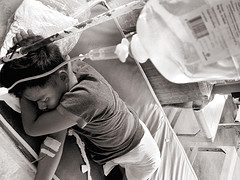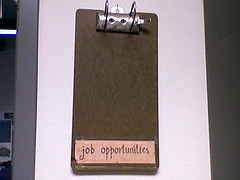by Michael Keizer on July 31, 2010

In this second interview in the series on the Zambian supply chain pilot, A Humourless Lot talks with Prashant Yadav, professor of supply chain management at the MIT-Zaragoza Logistics Program.
AHL: Could you tell us a bit more about your role in the project?
PY: I had conducted research on the medicines supply chain in Zambia in 2006 funded by the UK DFID which highlighted deficiencies in the system. After conducting the study to diagnose the supply chain problems, one of my specific mandates from DFID and the World Bank was to come up with four of five options that could possibly solve the issues that were identified in the earlier reports. A second task was to give input on measurement and the metrics to measure success vs. failure: what indicators to use and how to measure them in such a way that we could draw scientifically valid conclusions. We wanted to integrate monitoring and evaluation into the project from its earliest stages. Want to know more? Click here.
{
by Michael Keizer on July 19, 2010

The World Bank, The UK Department for International Development, and USAID recently released the results of a logistics pilot project in Zambia, in which the availability of various medical supplies was improved. This is the first of a three-part series in which I talk with two of the team members and finish with some personal reflections. In this first article in the series, I interview Monique Vledder, senior health specialist at the World Bank and supervisor of the project.
AHL: Could you tell us a bit more about the background of this project? Why was it initiated?
MV: We have been involved in supporting the government to implement malaria prevention programmes like bednet distribution in Zambia since 2005. However, over the course of our programmes we realised that, although the government was quite successful in preventing malaria, the people who still were infected could not get adequate treatment due to a lack of malaria treatment drugs at the rural health centres. Our analyses showed that those drugs were available at the central level and district level; but somehow they did not arrive at the health centres. Clearly, there was an issue with the supply lines between MSL (the central medical store), the districts, and the centres. We partnered with other major donors like the UK and US governments as well as JSI and Crown Agents as implementers, and with MIT to ensure academic support. Our joint analysis pointed towards placing commodity planners at the district level as the most promising option. When we discussed this with the Zambian government, we were given a strong commitment for for a pilot project to try this out. Click here to read on about this project
{
by Michael Keizer on June 27, 2010

Update July 4: Andrew points out a linguistic complication: in English, the adjective professional has a much wider meaning than the noun professional; in other words, one can be a professional without acting professionally. So please, read the article with this in mind and replace ‘a professional’ with ‘acting professionally’ where appropriate.
The ever-excellent Linda Raftree recently wrote an article about amateurs, professionals, innovations and smart aid. In it, she sketches in its extreme form two diametrically opposed views of volunteers and professionals: on the one extreme, volunteers are seen as well-meaning but utterly useless do-gooders who potentially do more damage than good, while on the other hand professionals are seen as useless ballast who are in no way capable of doing what they claim to do and who weigh down agile, smart new initiatives from volunteers.
I think that one of the big issues here is the conflation of amateur and volunteer, and of salaried aid worker and professional. In my view, being a volunteer does not automatically imply that you are an amateur, and some of the salaried aid workers out there are not professionals at all. I would say that there probably is a correlation between your contract status and your position on the amateur-professional continuum (although I have no evidence to back that up – just personal observation), but there is definitely no hard-wired link. What makes a professional? And are volunteers by definition amateurs? Read on…
{
by Michael Keizer on June 17, 2010

Kathleen McDonald asks for my views on INGOs who set up their own (parallel) supply lines for medical supplies, as opposed to using the country’s normal supply lines.
Let me start with a truism: horses for courses. When deciding to use the local supply chain or set up your own, you will need to take into account your programme needs as well as your environment; and that means that it is impossible to make any sweeping statements about which way to go is better.
Reasons to set up a parallel supply chain
Some of the reasons that INGOs give for setting up a parallel supply chain:
- Specific supplies are not locally available. Some programmes are so far ahead of what happens locally, that they use supplies that cannot be gotten through the national supply chain. This happened quite a lot in the early years of the international HIV response, when it was hardly ever possible to source antiretrovirals locally. It is still a consideration in some programmes.
- Local supplies are of unproven quality. An INGO that takes its duty of care towards its patients seriously, will want to ensure that medications and other medical supplies qualitatively sufficient. This is not always easy: local producers and distributors are not always open to audits by customers, especially not if they cannot be guaranteed a certain minimum amount of custom. National regulatory agencies in ‘weak’ nations often lack the means to adequately ensure quality.
- Local suppliers cannot scale up sufficiently. This can be a consideration in very large programmes or responses, especially in case of outbreaks/epidemics.
- Local supply chains have broken down (temporarily). This will often be the case after large disasters or areas that are prone to violent conflict.
- Local supplies are (much) more expensive than imported ones. It might be surprising, but in quite a number of cases imported supplies – even factoring in transport, taxes and import duties, clearing costs, and other incidental costs – can be cheaper than locally bought ones, sometimes by a large margin. This usually happens when only a small number of suppliers have a stranglehold on the market. So why not to set up a parallel supply chain? And what is best in the end? Click to read on…
{
by Michael Keizer on June 13, 2010
by Michael Keizer on June 11, 2010

- Crown Agents are looking for senior procurement specialists for their office in Arlington VA (USA) and Malawi; procurement specialists for Mongolia and Malawi; an ARV logistics officer for Botswana; a procurement consultant for Tanzania; a supply chain operations manager for Malawi; an SCMS deputy country director for Rwanda; a logistics assistant for their office in London (UK); public procurement advisors for several countries; and a team leader for Malawi
- Save the Children is looking for an operations director, a senior procurement specialist and two roving logistics specialists for Haiti; a senior manager procurement, contracts and compliance for the West Bank/Gaza; and two senior logistics specialists to be based in Washington DC (USA).
- Maxwell Stamp is looking for a project costing and procurement specialist for Laos
- UNICEF is looking for a procurement assistant for their office in Geneva (Switzerland), a contracts officer for their office in Copenhagen (Denmark), and a supply and logistics specialist for North Korea. Sorry, no links, they still hide their vacancies behind a registration process.
- DanChurchAid is looking for a field logistics officer for Katanga (Congo DRC).
- Merlin is looking for deputy logistics coordinators for Côte d’Ivoire and Congo (DRC); a logistician for Congo (DRC); logistics managers for South Sudan, Kenya, Pakistan, Congo (DRC), and the Central African Republic; a logistics/administration officer for Gode (Ethiopia); senior logisticians for Grand Kru and Montserado (Liberia); and a surge logistics officer for South Sudan.
- JSI is looking for a deputy chief of party SCMS for Nigeria.
- Concern Worldwide is looking for a transport manager for Haiti; an assistant country director systems for Afghanistan; and a general systems manager and a logistics and administration coordinator for Zambia.
- The IRC is looking for logistics managers for Congo (DRC) and Haiti.
- The IFRC is looking for a trainee logistics delegate for based in Kuala Lumpur (Malaysia), an operation coordinator for Guatemala, a head of support services based in Panama City (Panama), a procurement delegate for Haiti, and a senior procurement officer based in Geneva (Switzerland).
- MSH are looking for a senior program associate – supply planning/MIS/M&E for Bangladesh.
[Image: Job opportunities by Coffeechica. Some rights reserved.]
{
by Michael Keizer on May 27, 2010

The 1 million T-shirts saga goes on.
I really, really would wish that we could all just say that the T-shirt guys learned from what happened and we could move on to more rewarding issues. In fact, I thought exactly that had happened, and hadn’t spent even the shortest tweet on it for several weeks – and then they posted this blog post. Go and read. And cry.
Yes, that is right. They want to support what is probably the most badly conceived anti-child-trafficking initiative ever. I am not going to tire you here with why it is such a bad idea (others have done an admirable job on that, e.g. this post by Amanda Kloer, which was written well before the T-shirts ever came up). What I do want to draw attention to is that, evidently, Jason still has not learnt that it might be a good idea to stop and think before jumping off – and preferably only do so while being informed by best practice and evidence.
Obviously, he was taken aback a bit by the criticisms and quickly took the post down, tweeting that he did so for ‘due diligence’. Perhaps it should be pointed out here that ‘due diligence’ is normally understood as something done before the proverbial shit hits the proverbial fan. If you do this afterwards, it is more properly known as ‘negligent laziness’. Why do I go on a rant about this? Click to read on.
{
by Michael Keizer on May 26, 2010

Ordering systems come in two basic flavours: push and pull, plus any number of hybrid systems. All have pros and cons, and each is most appropriate for a specific situation. In this first article in a miniseries on push and pull systems, I will discuss the basics: what exactly are pull and push systems and when would you use either.
Push versus pull
In the push model, “higher”, central levels decide on supply allocation for “lower”, local levels; these decisions are typically based on supply at hand and in the pipeline, and on calculated expected consumption – the latter often approximated, based on (in the case of medical supplies) patient numbers or population data. In the pull model, “lower” levels decide on the necessary supplies for the next supply period, which are then either procured independently or obtained/ordered from the “higher” level.
The basic difference between the two models is the responsibility for timely, complete, and accurate initiation of distribution: in the push model this is the “higher” level, in the pull model the “lower” level. Click here to read more about push and pull systems
{
by Michael Keizer on May 14, 2010

You have designed and implemented a pretty good logistics system and are proud of how effective and efficient your aupply line provides your programmes with any materials they need. Transport and administration cost are now at their minimum, fulfilment rates are close to 100%, and you process and fill almost every order within set timeframes. You feel pretty good about yourself (and not without reason), and are ready to hand over the system to your successor with justifiable pride.
And then the ministry of trade announces that as of tomorrow, clearing rules will be changed, adding three weeks to the current four to five days it takes you to clear your goods. Suddenly things look a lot less optimistic: your carefully balanced and trimmed-down supply chain is strained to the snapping point, and you are looking at having some of your key operations suspended. Even worse: one of those is a treatment programme for TB patients, and suspension of treatment might cause resistance to the drugs involved – making a bad situation suddenly look catastrophic. What went wrong? Click to read on.
{
by Michael Keizer on May 12, 2010

- Mary’s Meals are looking for a logistics manager for Malawi.
- Oxfam GB is looking for a logistics coordinator and a procurement manager for Haiti; and an HSP supply and logistics coordinator (based in their HQ in England).
- IMC is looking for a logistics manager for Haiti, an operations manager for Sudan, and a logistics coordinator for Congo (DRC).
- UNICEF is looking for a logistics manager for Haiti.
- MSH are looking for a technical deputy director for Bangladesh.
- UNFPA is looking for a humanitarian logistics specialist, based in their HQ in New York (USA).
- ACTED is looking for a country logistics manager for Sudan, country logistics & security managers for Chad and Iraq, a logistics intern for Chad, and a pharmaceutical procurement manager for their HQ in Paris (France).
- JSI is looking for a deputy chief of party SCMS for Nigeria, and a supply chain advisor intern.
- Solidarités are looking for a logistics coordinator for Kenya/Somalia; a logistics support officer and a logistician for Haiti; and a flying logistician based in their HQ in France.
- Merlin is looking for a supply chain manager for Pakistan.
- Creative Associates International is looking for a procurement manager for Sudan.
- The British Red Cross is looking for logistics and procurement delegates for Bangladesh and Haiti.
- PSI are looking for an associate procurement & logistics officer, a procurement & logistics officer, and a voluntary pooled procurement & logistics officer, all for their HQ in Washington, D.C. (USA)
- The PNG Advisory Support Facility is looking for a procurement manager and operations advisor.
[Image: Job opportunities by Coffeechica. Some rights reserved.]
{









